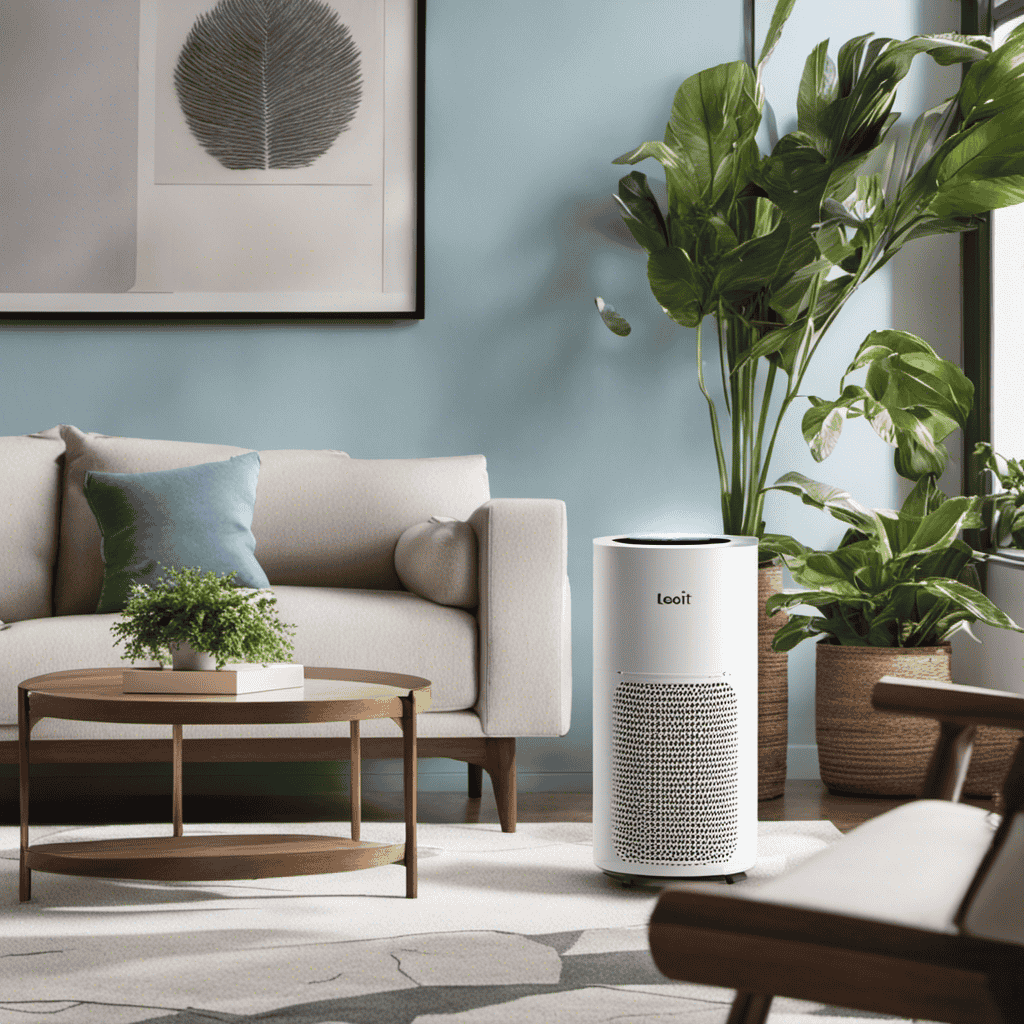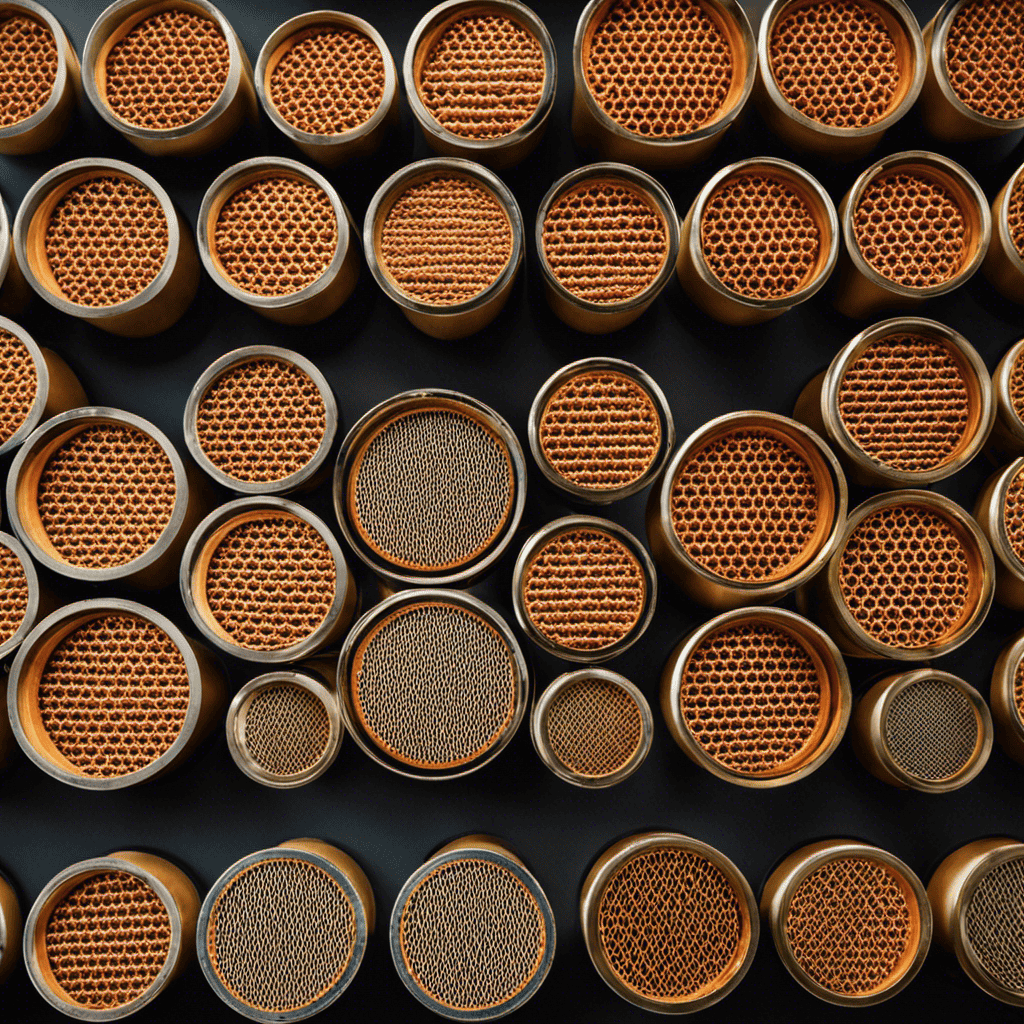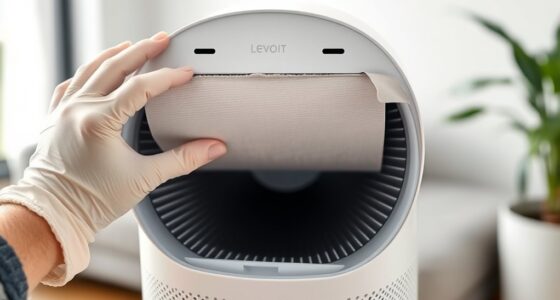As I explore the realm of air purifiers, a pressing question remains: where is the best location to place this device in my bedroom?
The answer lies in the intricate dance between size, proximity, and accessibility. In this article, I will guide you through the optimal placement of your air purifier, considering factors such as room dimensions, airflow patterns, and noise levels.
So, let’s delve into the depths of this purifying puzzle and uncover the perfect spot for our trusty air companion.
Key Takeaways
- Proper placement of the air purifier in the bedroom is crucial for its effectiveness in improving indoor air quality.
- Consider obstructions like furniture or curtains that may hinder airflow and position the air purifier centrally for maximum coverage.
- Window drafts and sunlight can disrupt airflow and impact the durability and functionality of the air purifier, so careful consideration should be given to placement in relation to windows.
- Position the air purifier closer to the source of pollutants and optimize airflow and circulation by avoiding placing it behind furniture or objects that obstruct airflow.
Size of the Room
You should place your air purifier in a spot where it can effectively clean the air in your bedroom, considering the size of the room.
When it comes to air purifier placement recommendations for small bedrooms, the size of the room plays a crucial role in determining the effectiveness of the purifier. The size of the room directly affects how well the air purifier can circulate and filter the air.
In a small bedroom, it is recommended to place the air purifier in a central location to ensure maximum coverage. This allows the purifier to effectively clean the air in all corners of the room.
Additionally, it is important to consider any obstructions such as furniture or curtains that may hinder the airflow of the purifier.
Proper placement in a small bedroom can greatly enhance the air purifier’s effectiveness in improving indoor air quality.
Proximity to Windows
When considering the proximity of an air purifier to windows, it is important to understand the potential effects of window drafts on its performance. Window drafts can disrupt the airflow and circulation within a room, reducing the effectiveness of an air purifier in filtering the air.
Additionally, windows can also allow sunlight and UV rays to enter the room, which can have an impact on the durability and functionality of the air purifier.
Therefore, it is crucial to carefully consider the placement of an air purifier in relation to windows in order to optimize its performance and prolong its lifespan.
Window Draft Effects
The window draft doesn’t affect the air purifier’s performance. However, it is important to consider the impact of window drafts on the overall ventilation needs and energy consumption of your bedroom.
Window drafts can lead to air leakage, which can affect the efficiency of the air purifier. When placed near a window draft, the air purifier may need to work harder to maintain the desired air quality, resulting in increased energy consumption.
To minimize the effects of window drafts, it is recommended to seal any gaps or cracks around the window. Additionally, placing the air purifier away from the window draft and ensuring proper airflow in the room can help optimize its performance and reduce energy consumption in the long run.
Airflow and Circulation
To optimize airflow and circulation, it’s important to position the air purifier in a central location within the room. This allows for better distribution of purified air throughout the space, ensuring maximum effectiveness of the air purifier. When choosing the ideal spot, consider the following factors:
| Factor | Description |
|---|---|
| Proximity to pollutants | Place the air purifier closer to the source of pollutants for better efficiency. |
| Room size | For larger rooms, consider placing the purifier near the center to evenly distribute purified air. |
| Obstructions | Avoid placing the purifier behind furniture or other objects that may obstruct airflow. |
Sunlight and UV Rays
Sunlight and UV rays can affect the air quality in your room, so it’s important to be mindful of their impact. Here are some key points to consider:
-
Benefits of sunlight for air purifiers:
-
Sunlight helps to naturally disinfect and purify the air by killing bacteria and viruses.
-
It can also help to reduce the growth of mold and mildew, which are common allergens.
-
Sunlight can improve the overall air quality in your room, making it fresher and healthier to breathe.
-
Effectiveness of UV rays in air purification:
-
UV-C rays, a type of UV radiation, have been proven to kill airborne pathogens like bacteria, viruses, and molds.
-
Air purifiers with UV-C technology can effectively neutralize these harmful particles, improving the air quality in your room.
-
UV rays can also help to eliminate odors and reduce the presence of volatile organic compounds (VOCs) in the air.
Distance From Bed
You should place your air purifier at least three feet away from your bed. This is important for both noise reduction and health benefits.
When an air purifier is too close to your bed, it can create unwanted noise that may disturb your sleep. By keeping a distance of three feet, you can minimize any noise produced by the purifier, allowing you to rest peacefully.
Additionally, placing the air purifier at a reasonable distance ensures that the clean air it produces can circulate effectively throughout the room, providing you with the maximum health benefits.
Once you have positioned your air purifier properly, you can move on to the next step: avoiding obstructions.
Avoid Obstructions
Once you’ve positioned your air purifier at a reasonable distance, make sure there are no obstructions blocking the airflow. This is crucial for the optimal performance of your device.
Here are a few things to keep in mind:
-
Placement: Ensure that your air purifier is placed away from walls, curtains, or furniture that may obstruct the airflow. This will allow the purifier to effectively circulate and filter the air in your bedroom.
-
Clear the Path: Make sure there are no objects or obstacles in front of or around the air purifier. It needs a clear path for the intake and output of air.
-
Avoid Corners: Placing the purifier in a corner can restrict the airflow and reduce its efficiency. Opt for a more central location in the room.
Choosing the optimal filter type and considering its impact on electricity consumption are also important factors to consider when setting up your air purifier.
Placement on Elevated Surfaces
Now that we have discussed avoiding obstructions, let’s move on to the next consideration for placing your air purifier in your bedroom: elevated surfaces.
Placing your air purifier on an elevated surface can have several benefits. First, it helps to ensure that the purifier is at an optimal height to capture airborne particles effectively. This can be particularly useful if you have pets or if your bedroom is prone to dust accumulation.
Elevating the purifier can also help to distribute clean air more evenly throughout the room. Just make sure that the surface is sturdy enough to support the weight of the purifier and that it is not near any potential obstructions.
With the placement on elevated surfaces covered, let’s now consider noise levels when choosing the ideal spot for your air purifier.
Consider Noise Levels
When placing your air purifier in your bedroom, it’s important to consider the noise levels to ensure a peaceful environment. Noise cancellation is a key feature to look for in an air purifier, as it helps minimize the disruptive sounds produced by the unit. Additionally, having the ability to adjust the fan speed can also contribute to a quieter operation.
Here are three important factors to consider regarding noise levels:
-
Noise Cancellation: Look for an air purifier that utilizes advanced noise cancellation technology to reduce operational sounds.
-
Fan Speed Adjustment: Opt for a unit that allows you to adjust the fan speed according to your preference, as lower speeds generally result in quieter operation.
-
Sleep Mode: Some air purifiers offer a sleep mode feature that automatically adjusts the fan speed to a quieter level during nighttime hours, promoting a more restful sleep.
Accessibility for Maintenance
It’s crucial to consider the accessibility for maintenance when choosing an air purifier for your bedroom. The ease of maintaining and replacing filters is an important factor to ensure the device remains effective in improving your indoor air quality.
When selecting an air purifier, look for models with easily accessible filter compartments that can be opened and closed effortlessly. This will make it convenient to replace filters as needed, allowing you to maintain optimal performance and prolong the lifespan of your air purifier.
Additionally, consider the availability and cost of replacement filters for the specific model you choose. Ensuring that replacement filters are readily available and reasonably priced will help you stay on top of regular maintenance and keep your bedroom air clean and fresh.
Consider Airflow Patterns
To optimize the effectiveness of your air purifier, make sure to consider the airflow patterns in the room you plan to place it. Proper placement can significantly improve the air quality in your bedroom. Here are some key factors to consider:
-
Furniture placement: Ensure that there are no large pieces of furniture obstructing the airflow around the purifier. Placing it in an open area will allow for better circulation and filtration of the air.
-
Room temperature management: Keep in mind that air purifiers work best in rooms with moderate temperatures. Extreme hot or cold temperatures can affect their performance. Therefore, it’s important to maintain a comfortable room temperature to maximize the efficiency of your air purifier.
-
Proper distance from walls: Avoid placing the air purifier too close to the walls, as this can hinder the airflow. Aim for a distance of at least 1-2 feet from the walls to allow for proper air circulation.
Considering these airflow patterns will ensure that your air purifier functions optimally and provides you with clean and fresh air for a healthier living environment.
What Are the Best Locations for Air Purifiers in a Bedroom?
When considering air purifier placement in bedroom, it’s important to locate the device near the bed and away from any obstructions. Placing the air purifier near the bed can help ensure that you breathe in cleaner air while you sleep, improving the overall air quality in the room.
Frequently Asked Questions
Can I Place My Air Purifier in a Small Closet or Under the Bed?
I wouldn’t recommend placing the air purifier in a small closet or under the bed. These locations may restrict airflow and hinder the purifier’s effectiveness. It’s best to position the purifier in an open area for optimal performance.
Should I Keep My Air Purifier Near the Door or on the Opposite Side of the Room?
I should keep my air purifier near the window or in the middle of the room. Placing it on a high shelf or on the floor depends on personal preference and the purifier’s design.
Can I Place My Air Purifier on a Bookshelf or a Desk?
I can place my air purifier on a bookshelf or a desk. However, it’s important to consider factors such as airflow, accessibility, and stability. A bookshelf placement may limit airflow, while a desk placement offers easier access and stability.
Should I Avoid Placing My Air Purifier Near Electronics or Appliances?
I should avoid placing my air purifier near electronics or appliances as it may interfere with their functionality. Additionally, I should avoid placing it near curtains or drapes to prevent any obstructions to the airflow.
Can I Place My Air Purifier Near a Plant or a Pet’s Bed?
I can place my air purifier near a plant to benefit from its air-cleansing properties. However, I should avoid placing it near a pet’s bed if I have allergies, as it may not effectively remove pet dander.
Conclusion
Well, after considering all the factors and guidelines for placing an air purifier in your bedroom, it seems like the only logical conclusion is to abandon the idea altogether.
I mean, who needs clean air anyway? Let’s just continue breathing in all that dust, pollen, and other pollutants while we sleep. Who needs a good night’s rest when we can have allergies and respiratory issues instead?
So go ahead, forget about improving the air quality in your bedroom and embrace the wonders of sneezing and coughing all night long.
Sweet dreams!










